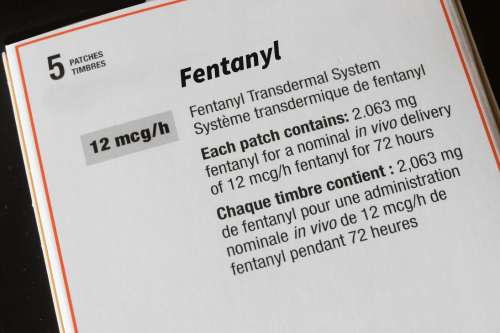What Does Fentanyl Taste Like?
Fentanyl is a synthetic opioid, a type of drug designed to mimic the effects of natural opioids like morphine. Originally developed for pain management in cancer patients and those with chronic pain, fentanyl’s potency has led to its widespread misuse and drug abuse, particularly with fentanyl-laced substances. This misuse has significantly contributed to drug overdose deaths, with fentanyl playing a major role in the increasing number of fatalities.
As this potent drug continues to infiltrate the illicit drug market, one critical question that arises is, “What does fentanyl taste like?” Understanding the characteristics of fentanyl, including its taste, can play a vital role in identifying this dangerous substance, especially when mixed with other street drugs.

The Taste of Fentanyl
Pharmaceutical fentanyl, typically administered in controlled medical settings, does not have a distinctive taste that can be easily identified by users. It is often described as having a slightly bitter or metallic taste, common among synthetic opioids. However, this taste is not always noticeable, especially when fentanyl is combined with other drugs. The combination of substances can significantly alter the taste, making it difficult to identify fentanyl by taste alone.
When fentanyl is mixed with other drugs like heroin, cocaine, or pressed into counterfeit pills, the taste can vary widely. The other substances present in the mixture can mask the taste of fentanyl, making it nearly impossible for users to detect its presence through taste. This is particularly dangerous, as many individuals who consume these drugs are unaware they are ingesting fentanyl, leading to an increased risk of overdose.
The Danger of Synthetic Opioids
Fentanyl is part of a broader category of drugs known as synthetic opioids. These are man-made substances designed to produce effects similar to those of natural opioids but are often much more potent. Fentanyl, for instance, is estimated to be 50 to 100 times more potent than morphine and about 50 times more potent than heroin. This extreme potency makes even small amounts of fentanyl potentially lethal.
The rise of synthetic opioids like fentanyl has been a significant factor in the increase in opioid overdose deaths in recent years. The Centers for Disease Control and Prevention (CDC) reports that deaths involving synthetic opioids, including fentanyl, have risen sharply, contributing to the broader opioid overdose crisis. The taste of fentanyl may be subtle, but its effects are anything but, highlighting the need for awareness and prevention efforts.

Illicit Fentanyl: A Hidden Danger
Illicit fentanyl, often manufactured in clandestine labs, poses a significant public health threat. Fentanyl abuse can develop rapidly, leading to severe addiction and devastating effects on both physical and mental health. Unlike pharmaceutical fentanyl, which is carefully dosed and administered under medical supervision, illicit fentanyl is frequently mixed with other drugs and sold on the black market. This practice increases the risk of accidental overdose, as users often do not know the strength of the drug they are taking or that it even contains fentanyl.
One of the most insidious aspects of illicit fentanyl is that it is often mixed with other substances without the user’s knowledge. This can include other opioids, stimulants like cocaine, or even substances like powdered sugar or baking soda. These mixtures can completely mask the taste of fentanyl, making it undetectable by taste alone. This means that even experienced drug users may not realize they are ingesting fentanyl until it is too late.
The Role of Fentanyl Test Strips
Given the difficulty in detecting fentanyl by taste or appearance, various testing methods have been developed to detect fentanyl in the body and in drugs. Fentanyl test strips have become an essential tool in harm reduction efforts. These test strips are designed to detect the presence of fentanyl in a drug sample, providing users with critical information about the substances they are about to ingest. While not a perfect solution, fentanyl test strips have proven effective in reducing the risk of accidental fentanyl ingestion and overdose.
Fentanyl test strips are easy to use and relatively inexpensive, making them accessible to a wide range of people. To use a fentanyl test strip, a small amount of the drug is mixed with water, and the test strip is dipped into the solution. Within minutes, the strip will indicate whether fentanyl is present in the sample. While these test strips are not 100% accurate and may not detect all fentanyl analogs, they are a valuable tool in the fight against the opioid overdose crisis.
The Devastating Impact of Fentanyl Overdose
The taste of fentanyl may be difficult to pinpoint, but the consequences of its use are unmistakable. Fentanyl abuse has played a significant role in the increasing number of overdose deaths, highlighting the dangers and severe consequences of abusing this potent drug. Fentanyl overdose has become one of the leading causes of drug-related deaths in the United States. Due to its potency, even a small amount of fentanyl can cause a fatal overdose. The drug acts on the brain’s opioid receptors, slowing down breathing to the point where it may stop altogether, leading to death.
Fentanyl overdoses often occur quickly, with little warning. Unlike other opioids, which may provide a brief “high” before causing respiratory depression, fentanyl can lead to immediate unconsciousness and death. This is particularly true when fentanyl is mixed with other depressants like alcohol or benzodiazepines, which can amplify its effects. The rapid onset of a fentanyl overdose leaves little time for intervention, making it a particularly deadly substance.

The Challenge of Fentanyl Addiction
In addition to the risk of overdose, fentanyl, a powerful synthetic opioid approved by the FDA to treat severe pain, is highly addictive. Even those who start using fentanyl under medical supervision for severe pain can quickly develop a tolerance, requiring higher and more frequent doses to achieve the same level of pain relief. This can lead to a cycle of dependence and addiction that is incredibly difficult to break.
Fentanyl addiction often requires comprehensive treatment, including medical detoxification, behavioral therapy, and ongoing support to address the psychological aspects of addiction. Withdrawal from fentanyl can be particularly challenging, as the drug’s potency leads to severe withdrawal symptoms, including intense cravings, anxiety, depression, and physical discomfort. Without proper treatment, the risk of relapse is high, making it essential for those struggling with fentanyl addiction to seek professional help.

Identifying Fentanyl: Beyond Taste
While the taste of fentanyl might be indistinct, there are other ways to identify its presence. It is crucial to use fentanyl test strips to detect fentanyl in drugs, as the drug is odorless and can be easily missed. Fentanyl is often found in powdered form, which can be white, off-white, or brown. It may also be pressed into pills that look identical to other prescription medications, such as oxycodone or Xanax. These counterfeit pills are particularly dangerous because they are often indistinguishable from the real thing, both in appearance and taste.
In some cases, fentanyl may be mixed with heroin or other drugs and sold as a stronger or “enhanced” version of the drug. This practice is incredibly risky, as users may unknowingly ingest a lethal dose of fentanyl. For this reason, it’s essential to be cautious when using any street drugs and to consider using fentanyl test strips to check for the presence of this deadly substance.
Conclusion
Fentanyl is a powerful synthetic opioid with a potentially deadly impact. Its taste may be subtle or even unnoticeable, and the fentanyl smell can be faint or masked, especially when mixed with other substances. However, the dangers it poses are unmistakable. As fentanyl continues to drive up drug overdose death rates, understanding its characteristics, including both taste and smell, and taking proactive steps to prevent accidental ingestion is more important than ever.
For those struggling with fentanyl addiction or concerned about the risk of overdose, seeking help from an addiction treatment provider is critical. Early intervention can save lives and provide the necessary support to overcome addiction. Fentanyl is not a drug to be taken lightly, and understanding the risks associated with its use, including the potential for overdose, is the first step in preventing further tragedies.

FAQs For What Does Fentanyl Taste Like?
Fentanyl typically has a slightly bitter or metallic taste, but it can be difficult to detect, especially when mixed with other substances. The taste alone is not a reliable way to identify fentanyl, making it crucial to use other detection methods, such as fentanyl test strips.
Fentanyl generally does not have a distinctive smell, and any odor might be masked when it is mixed with other substances. Because of this, relying on smell to identify fentanyl is not effective. The absence of a strong fentanyl smell adds to the challenge of detecting this dangerous drug.
Recognizing fentanyl in street drugs is critical because it is extremely potent and can cause a fatal overdose even in small amounts. Fentanyl is often mixed with other drugs without the user’s knowledge, leading to a significant increase in drug overdose death rates.











